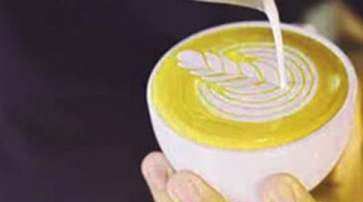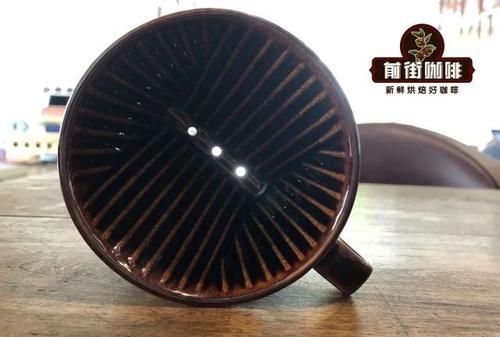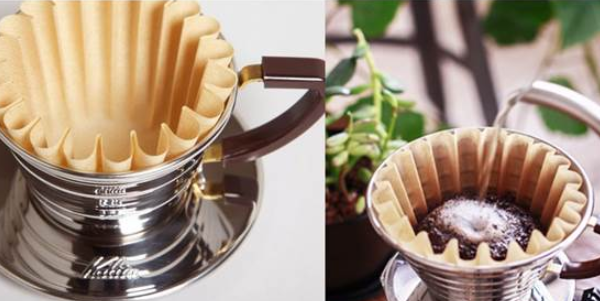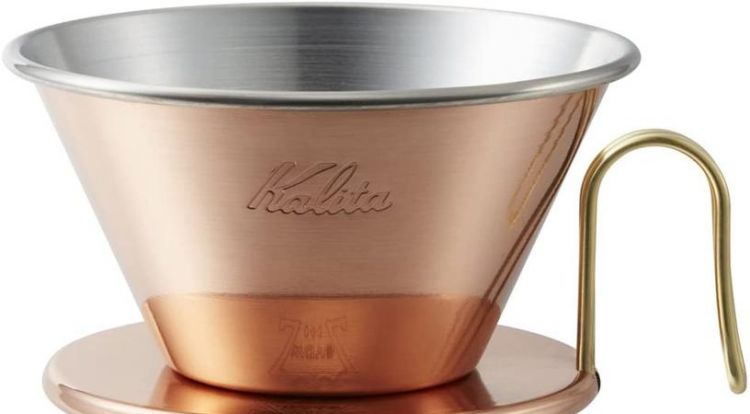Contents of this article
- 1. The world’s first drip coffee cup
- 2. The history of the principle of brewing coffee with a hand brewing pot
- 3. Is it better to have a single hole filter cup or a three hole filter cup?
- 4. Is hand-brewed coffee so popular?
The world's first drip coffee cup
What are the coffee filter cups-Seven popular types of coffee filter cups in the world
Do you know what are the popular coffee filter cups in the world? Below, I will share with you seven popular coffee filter cups in the world, come and find out!

Hario V60 filter cup
V60 caters to the many variables in coffee making
Mainly lies in the design of these three points:
1. 60-degree cone shape: This prolongs the time it takes for water to flow through the coffee grounds toward the center.
2. A large filter hole: This allows us to control the flavor of the coffee by changing the flow rate of the water.
3. Spiral pattern: This allows air to escape upward from all sides to maximize the expansion of the coffee powder.
V-shaped conical filter cups are not unique to Hario. Kalita, Kono and Tiamo have all developed V-shaped conical filter cups, while the conical filter cups of other companies are all linear with radial grooves. Only the spiral groove is Hario's unique patent, and the filter holes of V60 are also larger than those of other companies. Therefore, the brewing time of drip coffee is relatively short, and you can enjoy a pure and smooth taste.
American dripping pot
The American-style filter pot is a coffee pot invented in the United States in 1941 by Dr. Peter J. Schlumbohm, who was born in Germany. Its design and uniqueness were recognized, and it was not only selected as one of the top 100 modern products of the "Illinois Institute of Technology", but was also displayed as a permanent collection of the "Smithsonian and the Philadelphia Museum of Art" by MoMa in New York.
The uniqueness of the American drip pot is that the coffee pot and filter cup are integrated instead of separate. The slender waist, wrapped in wood and leather ropes, is quite high-end and elegant. But the secret to pure yet flavorful coffee lies elsewhere.
There is an air channel (air channel) in the upper part of the American-style filter cup, which is funnel-shaped. It can supply air smoothly when extracting coffee, and the filter paper can be easily removed after use.
The filter paper of American-style bubble teapots is not funnel-shaped, but flat square or round filter paper. Perhaps it's because the inventor once had a PhD in chemistry. The filter paper used in American-style filter teapots is about twice as heavy as ordinary filter paper, but its advantage is that it can drip out strong coffee without bitterness.
Kono filter cup
The coffee filter cups produced by the Japanese company KONO are also very popular among coffee lovers.
Features: The drainage groove extends to the bottom of the hole. Although the drip filtering time is short, it will pile the coffee particles narrowly and deeply, causing the water flow to pass through the coffee powder for a relatively longer time, and the coffee extraction taste will be relatively rich.
Melitta single hole filter cup
In 1908, Mrs. Melita of Germany invented and patented the first invention.
Features: Slow flow rate, suitable for medium-dark roasted coffee. Lightly roasted coffee can easily clog the filter holes.
When brewing with a Melitta cup, you need to measure the amount of coffee powder and water in advance. After the steaming is completed, pour it in and drip it all at once.
Kalita three-hole filter cup
Features: There are many filter holes and it is not easy to get clogged. It is suitable for coffee with different roasting degrees and is suitable for using multiple stages of water injection during the brewing process.
;The history of the principle of brewing coffee with a pour-over pot
1763, France. Paris metal craftsman Don Martin invented the "Martin coffee pot". Fix the long cloth bag on the metal ring and place it in a coffee pot with a water injection port for heat preservation. Fill the bag with coffee powder and pour hot water from above for extraction (as the amount of water added increases, the coffee liquid will filter from smooth to Complete immersion of powder and hot water, this is the combination of filtration and soaking). This is regarded as a revolutionary invention in the history of coffee extraction, and the Martin coffee pot is also regarded as the origin of drip coffee.
1908, Germany. Mrs. Melita invented the filter paper and filter cup, and the filter paper filtration method was officially born.
Pour coffee powder into the filter paper of the filter cup, then add hot water, and extract the coffee liquid by simply soaking and filtering. Compared with metal filter coffee pots and Turkish pots, this method makes hot brewed coffee taste cleaner and is more convenient than cloth bag filtration.

Is a single hole filter cup better or a three hole filter cup?
A one-hole filter cup is called a Melita cup.
The main difference between filter cups is the filter holes at the bottom of the cup. Currently, there are four main types of single-hole, double-hole, three-hole filter cups and V-shaped filter cups.
1. The single-hole filter cup was invented by Mrs. Melitta of Germany, and is commonly known as the "Melita cup". Single-hole filter cups are mainly used for medium-dark roasted coffee such as German roast, while light-roasted ones are more likely to plug the filter holes.
2. The three-hole filter cup has many filter holes and is not easily clogged. It is suitable for coffee of various roasting degrees, and the concentration can be adjusted by adjusting the extraction amount. The three-hole filter cup is called a "Kalita cup".
3. The effect of the double-hole filter cup is between single hole and three holes.

The function of the groove:
The main function of the groove in the filter cup is to allow air to pass through between the filter paper and the filter cup, so that the coffee powder can be fully steamed. If there is no groove, or if the filter paper is placed close to the filter cup with extremely shallow grooves, the air can only be discharged through the filter holes at the bottom of the cup after hot water is injected. As a result, a large amount of air that cannot be discharged will be evaporated like a volcanic eruption. The surface of the coffee powder rushes out, and a hole is opened on the surface of the powder, allowing cold air to enter, resulting in insufficient steaming.
Is hand-brewed coffee so popular?
The essence of hand-brewed coffee: extraction & filtration
In order to drink clean coffee without grounds, smart humans invented filter paper to separate the coffee liquid from the coffee grounds.
<Coffee filter paper was invented by Ms. Melita in Germany in 1908>
But there is a problem again. The filter paper needs something to support it to better separate the coffee grounds from the coffee liquid. We call this the ability to carry the filter paper. The utensil for mixing coffee powder is a "filter cup".
With the filter cup, filter paper, a hand brewing pot, and a bottom pot that can hold coffee liquid, the hand brewing equipment is basically complete!
The filter supports the filter paper. Pour freshly ground coffee powder into the filter paper and pat it flat. Then, use a kettle to pour hot water into the filter paper containing the coffee powder: after the hot water fully contacts the coffee powder, pour it into the filter paper. The beautiful ingredients are extracted, and then the coffee liquid is separated from the coffee powder through the filter paper.
Any coffee brewed in this way can be called "hand-brewed coffee".
3| Why is pour-over coffee so popular?
For me, the most important reason is of course that it tastes good!
Just use hot water to extract the beautiful substances in the coffee beans, without adding anything else. This simple and direct brewing method makes it easier to drink the taste of the coffee itself!
The ever-changing coffee flavors brought about by different varieties/different origins/different processing methods are the reasons why more and more people are fascinated by hand brewing.
A cup of delicious hand-brewed coffee is clean, balanced, rich in layers, and has a distinct flavor. You can enjoy the personality of different coffee beans. African beans have bright acidity as bright as the sunshine there; while Indonesian coffee beans have a strong aroma and low acidity.
In addition, there are well-made, delicate and elegant hand brewing kettles, filter cups of various shapes and materials...the dazzling array of hand brewing utensils are pleasing to the eye just by being placed there, revealing their owners. Good taste in home.
In the morning, if you can prepare a hearty breakfast for yourself and make a cup of delicious coffee, I believe that your good mood will be brightened for the day!
Weigh the coffee beans, grind them into powder, enjoy the happiness surrounded by the aroma, lightly wet the filter paper, pour in the coffee powder and pat it flat, then patiently pour in hot water, and finally drip filter and take out the cup.
Hand-pasting gives people a rare sense of calmness and concentration. Our fast-paced life is so in need of healing~
4
|In fact, it is not troublesome, and anyone can do hand-pasting!
Is it difficult to make coffee by yourself? actually not.
If you are willing to spend 3 minutes making a pot of tea, then making a cup of coffee is not difficult.
For example, the process of making tea can be as simple as just needing a glass and hot water, or it can be as elaborate as covering a bowl, a scent cup, and a fair cup. The same goes for making coffee.
Hand brewing is simple and scientific.
To put it simply, as long as the ratio of powder to water is mastered and the water flow is controlled to a certain degree of stability, whether the coffee is thicker or lighter, whether it is more bitter or sour, can be controlled by the person making the coffee.
As for utensils, if you feel that carrying a bunch of utensils when going out is too cumbersome, then the ear-hanging bag only requires hot water and a cup! "Ear-hanging bag" can be understood as the simplest and simplest "hand-brewed coffee".
The ear-hanging bag itself is "filter paper", and the small ears that we often overlook and forget to fold are just a simple support (I still have to say a few words, when drinking ear-hanging bags, remember to fold the small ears and then hang them on the cup Oh), add hot water and the coffee will brew quickly. Although there is inevitably some loss in freshness and flavor, it is so convenient.
Scientific because hand-brewed coffee is like an interesting experiment that constantly awakens your inner spirit of exploration. As your understanding of coffee gradually deepens, you want to understand the degree of grinding of coffee beans, water temperature, water quality, water flow, extraction time, and even the technique and timing of water injection. Every small change in factors will have an impact on the final flavor. .
So, drink more, compare and practice more, so that the cup of coffee in your hand can become closer and closer to what you have in mind.

The above is all about the history of the Melita filter cup, the world's first coffee drip filter cup, and Melita-related content. I hope it can help you.
